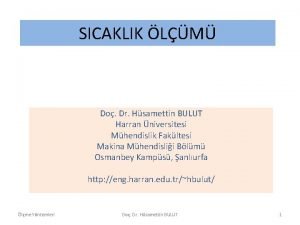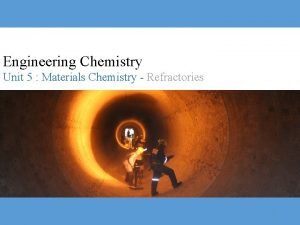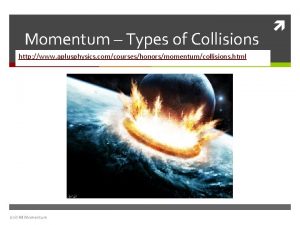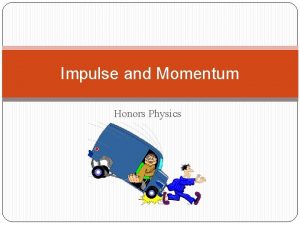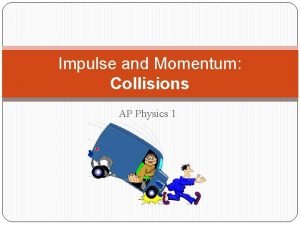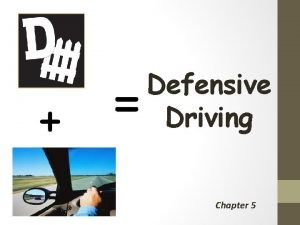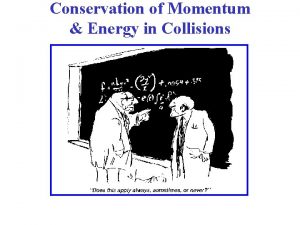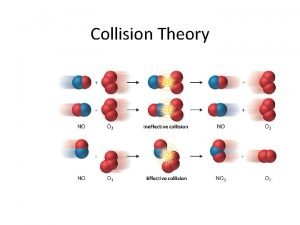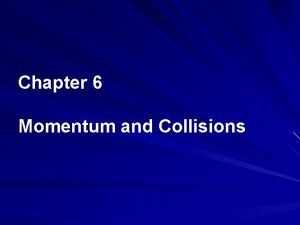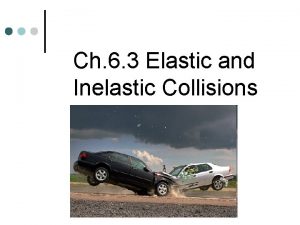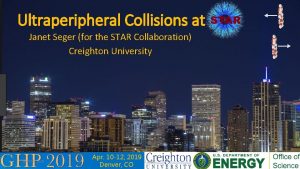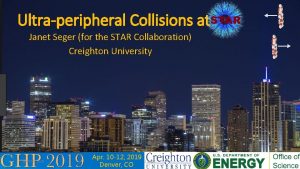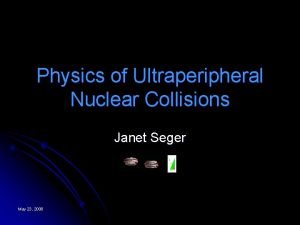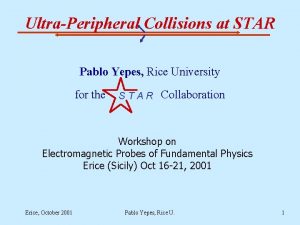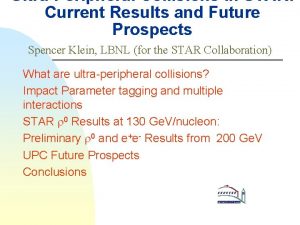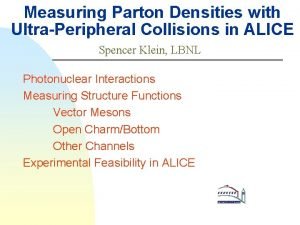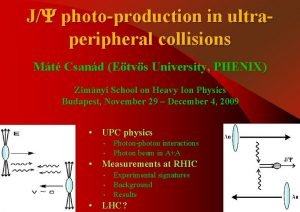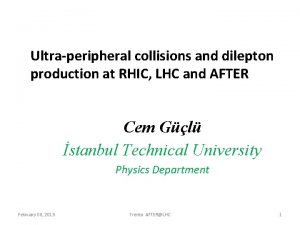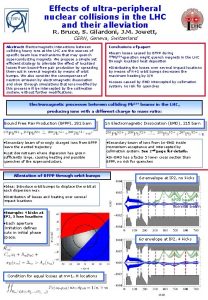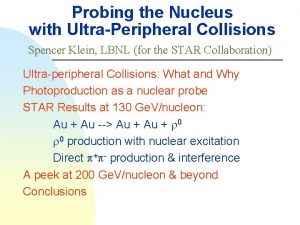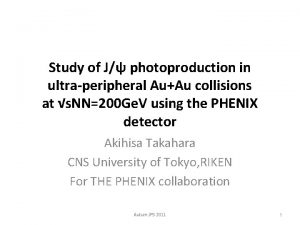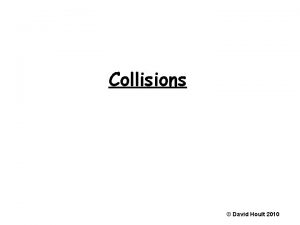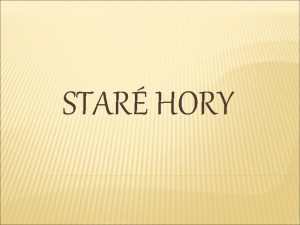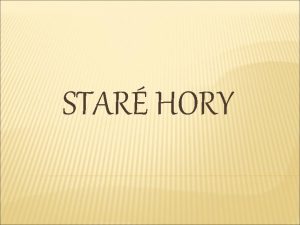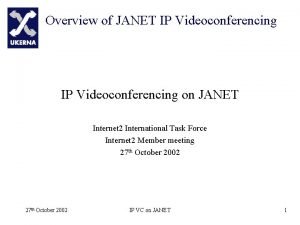UltraPeripheral Collisions at STAR Janet Seger Creighton University






















- Slides: 22

Ultra-Peripheral Collisions at STAR Janet Seger, Creighton University for the S T A R Collaboration • STAR Detector • Ultra-Peripheral Collisions • Triggers • First results Coherent rho production Electron pair production Direct pion production

STAR Detector Coils Magnet Silicon Vertex Tracker E-M Calorimeter Time Projection Chamber Trigger Barrel Electronics Platforms Forward Time Projection Chamber


Central Gold-Gold Collisions at 130 Ge. V/nucleon Minimum-bias Trigger: (Au Au, 200 Ge. V/nucleon, University of Frankfurt) • Coincident neutrons in both zero-degree calorimeters • ~800, 000 triggers Up to 2000 tracks/event

Ultra-Peripheral Collisions Two nuclei ‘miss’ each other and interact via their photon fields at impact parameters b > 2 RA • Mostly 2 -track events • Coherent coupling to both nuclei • Nuclei may be mutually excited • Large background Incoherent photo-nuclear interactions, Beam-gas events, Cosmic rays, Hadronic interactions (peripheral AA), Upstream interactions… Triggering is Crucial!

Coherent Coupling Strength: • Photon Z 2 ( Z for incoherent coupling to single nucleon) • Pomeron A 4/3 to A 2 Cross sections are large Coherence condition: • Longitudinal momentum p. L < gh/RA ~ 3 Ge. V/c << p nuclei • Small Transverse momentum • p. T < 2 h/RA~ 50 Me. V Clear signature of coherent events; acceptance may be small

Photon-Photon Interactions: gg leptons, mesons Example: electron pair production Au g g ee+ Au • Purely electromagnetic • Exclusive process • Strong field QED Za ~ 0. 6 • Large cross section Z 4 a 4 (33 kb at RHIC) • Acceptance/efficiency small

Photonuclear interactions • Photon fluctuates to pair • pair can emerge as vector meson – r, w, F, J/y • Large cross section – 380 mb for r 0 in Au collisions at 130 Ge. V • Two sub-channels– with and without nuclear excitation

Nuclear Excitation Nuclei may exchange one or more separate photons and become mutually excited. Au*+n Au g r 0 g P Au+Au Au*+Au* + r 0 Au Au*+n • Cross section factorizes • Decay of excited nuclei yields neutrons in Degree Calorimeter Zero

Direct p+p - production pp+ g g. A p+ p- A r 0 g pp+ g. A r 0 A p+ p- A • Two diagrams interfere – Constructive below M(r 0); destructive above it • Well-studied with gp • greater for p+p- than for r 0 – p+ p- fraction should decrease as A increases

Interference Fundamental Quantum Mechanics Can’t differentiate between projectile and target Expected Signal No Interference 2 -slit interferometer! r, w, f, J/y have negative parity: destructive interference at p. T=0 S. Klein and J. Nystrand, Phys. Rev. Lett. 84(2000)2330

Ultra-Peripheral Collisions Trigger Level 0 Back-to-back hits in Central Trigger Barrel • Coincidence 1 North + 1 South hit • Veto on top + bottom (reject cosmic rays) • Rate: 20 -40 Hz Level 3 -online reconstruction • Vertex position • Charged multiplicity • Accepted 1 -2 Hz Data Set • ~ 7 hours of dedicated data collection • 30, 000 triggers

ZDC Signals for 2 -track events Ultra-Peripheral Trigger • Pedestal peak at ADC sum = 4 • Higher ADC values usually in east or west only (beam gas events) Pedestal Minimum Bias Trigger • Single neutron peak around ADC =9 coincident in east and west • Higher ADC values from hadronic peripheral events Single neutron peak Reject events ADC>7 Observe two different processes ! Reject events ADC>30

Observed with Peripheral Trigger: Au+Au + r 0 Au g r 0 P Au Observed with Minimum-Bias Trigger: Au+Au Au*+Au* + r 0 Au Au*+n g P r 0 g Au

Event Selection Criteria • Vertex within interaction region |zvertex| < 200 cm and |x, yvertex| < 2 cm • Exactly 2 tracks with net charge zero • ZDC cuts • Opening angle < 3. 0 rad (reject cosmic background) Cosmics

Rho events with Peripheral Trigger Signal region: p. T<0. 1 Ge. V P i l re i m y r a n • Au+Au+r • Uncorrected • mpp spectrum peaks near r 0 mass • peak at p. T < 100 Me. V/c – Clear evidence that production was coherent

Rho events with Minimum-Bias Trigger Signal region: p. T<0. 1 Ge. V y r na Pr i m i l e • Au+Au Au*+r • Uncorrected • mpp spectrum peaks nea r 0 mass • peak at p. T < 100 Me. V/c – Clear evidence that production was coherent

STARlight Monte Carlo Simulation vs. data: r 0 pt spectrum • STARlight Monte Carlo S. R. Klein and J. Nystrand, STAR Note 347 – Simulates rapidity, transverse momentum and angular distributions for photon-photon, photon-Pomeron and photonmeson interactions – Does not (yet) include interference, backgrounds, and full detector simulation Pr eli mi na ry • Min. Bias dataset – 0. 62 Ge. V < mpp < 0. 92 Ge. V – uncorrected Reasonable match between Monte Carlo and data

Analysis of e+e- Pairs Selectrons from -bias data: • p < 0. 13 Ge. V • -0. 2 < log(z) <0. 3 min y r a n i m • Min-bias data with two oppositely-charged tracks • Identified electrons i l re P Selected pairs show a peak at very low p. T Coherent process Au+Au Au*+e++e-

Fit r 0 mass lineshape ZEUS gp --> (r 0 + p+p- )p STAR g. Au --> (r 0 + p+p- )Au Fit Data Prel imin ary r 0 p+p- Set =0 for STAR interference is significant p+ p- fraction is high (electron pairs have not been removed)

Summary • We observe exclusive r 0 production in both peripherally-triggered and minimum bias data sets Observation of both interactions: Au + Au -> Au + r 0 Au + Au -> Au* + r 0 • Peaks at low transverse momentum indicate both processes are coherent. • We observe interference between rho production and direct pion production. • We observe coherent electron-pair production. First observation of Ultra -Peripheral Collisions in heavy ion interactions

Year 2001 Run • Full field (0. 5 T) • Peripheral Trigger in parallel with Central – Better calibrations • May have some functionality from MWC – Acceptance at higher h • Better statistics more channels
 Bearing gifts we traverse afar
Bearing gifts we traverse afar Hüsamettin bulut termodinamik
Hüsamettin bulut termodinamik Neutral refractory material factory
Neutral refractory material factory Career center creighton
Career center creighton Creighton honors program
Creighton honors program Creighton global engagement office
Creighton global engagement office Wade pearson
Wade pearson Ilac dominican republic
Ilac dominican republic Creighton cubuyplus
Creighton cubuyplus Creighton flpa
Creighton flpa David reed creighton
David reed creighton A* algorithm and ao* algorithm
A* algorithm and ao* algorithm What does star events stand for
What does star events stand for Types of collisions/ impulse graphs answer key
Types of collisions/ impulse graphs answer key Momentum of collision
Momentum of collision Types of collision
Types of collision Ap physics collisions
Ap physics collisions To avoid collisions a defensive driver should
To avoid collisions a defensive driver should Completely inelastic collision
Completely inelastic collision Elastic vs inelastic
Elastic vs inelastic Which is/are necessary for successful collisions to occur
Which is/are necessary for successful collisions to occur A small marble collides with a billiard ball
A small marble collides with a billiard ball Elastic potential energy real world examples
Elastic potential energy real world examples

